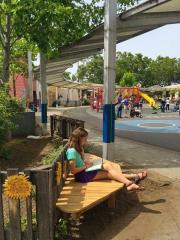National Green Independent Schools Survey
Environmental Education and Sustainability in American Independent Schools
In September 2013 Inverness Associates conducted a comprehensive, national survey of environmental education and sustainability among private independent schools across the country. The National Association of Independent Schools (NAIS) and fourteen regional and state associations supported the research. With 678 school heads in 46 states and the District of Columbia participating out of 1879 surveyed, the 36% response rate clearly indicates a strong interest in this issue. Overall, the survey response was broadly representative of the wider NAIS community in terms of several indicators: day/boarding coed/single gender, grade level structure, religious affiliation, location and size. The survey sought an understanding of how schools’ environmental educational programs develop environmental literacy among students--environmental knowledge, skills, attitudes and behaviors they need to become environmental stewards. The survey also examined the broader issue of how schools are becoming more environmentally sustainability in terms of efficient use of resources, healthy operations, and an ecological curriculum.
The research originated in part from the 2005 NAIS study “Forecasting Independent Education to 2025,” which identified “five keys to sustainability in the 21st century,” among them becoming “more green and less wasteful.” The survey findings themselves were augmented by in-depth profiles of over 100 schools across the country included in Greening America’s Schools and Greening 2.0 (NAIS 2012, 2013), which tell the stories of the many paths taken by schools on their journey to sustainability. The survey results provide a detailed portrait of the successes and challenges experienced by independent schools incorporating environmental education and sustainability practices. And the results make plain the leading role many independent schools are playing in greening our country’s schools.
I. Central Conclusions
The national survey demonstrates that there is remarkably widespread engagement with environmental education (EE) and, more broadly, environmental sustainability in our schools. In all areas of operation—overall organization, efficient use of resources, healthy operations, environmental curriculum, food and nutrition, and student leadership--the survey shows that many independent schools are making environmental sustainability a priority. Yet, the survey also reveals that independent schools need to adopt a more systematic and systemic approach to environmental education and sustainability.
Interest in EE and sustainability is very high, especially among administrators, faculty and students, who are motivated by their concern for the environment. Many schools are organizing around an environmental mission, policy, strategic plan and a green team. Some schools have sustainability coordinators but most efforts are headed by volunteers. Financial support for EE and sustainability is modest with half the schools spending less than $5,000 per year on non-construction activities. A great majority of schools are working to lower their environmental impact through waste reduction, recycling, composting, and energy efficiency. A large number of schools have gardens and are offering nutritious food. A quarter of schools are incorporating green building practices in new construction and renovation. The integration of (EE) in the curriculum is beginning.
The following comments from school heads illustrate the benefits and success factors among schools going green.
- “Our faculty, staff and students have pride in being environmental stewards and leaders in our community.”
- “Our students graduate with an environmental ethic.”
- “Our goal is to help children develop healthy habits, awareness and concern for the health of the planet.”
- “Reducing our environmental footprint has provided a rallying point that has been good for campus morale.”
- “The community is aware of our practice and thus it has become part of our mission, values and consequently our culture.
- “Our school philosophy and mission includes "compassion," and we approach environmental sustainability as a means of showing compassion for our planet.”
- “Our headmaster and members of our board saw how much sustainability as a mindset and lens can help integrate the school in a coherent fashion; by hiring a Director of Sustainability, we have been able to bring all of the different parts together coherently.”
- “Having a committed "champion" for the overall cause has been the single biggest reason for the School's enormous success in the last two years.”
- “The physical environment has benefited greatly from our sustainability policies; not only have we reduced expenses and our waste stream, but our indoor air quality is much improved, and as a result, both humans and the environment are healthier.”
- “Benefits for our school include significant cost savings and meaningful work for students as agents and leaders of positive change within school and global contexts.”
In addition to illuminating best practices and successes in schools going green, the survey also points to key needs and challenges that must be addressed to make further progress. To address the challenges of incorporating EE and sustainability, heads would like more money, time, and staff. They want better organization and designated leadership. A greater commitment from the board of trustees, an overall sustainability plan for their schools, and outside consulting support are key elements needed for improvement. Heads would like more buy-in, enhanced staff training, and more integration of environmental education into curriculum.
The following comments from school heads describe some of the challenges faced by schools going green.
II. Detailed Findings
- Waste reduction, recycling and/or composting programs are widespread (93%), although many report the need to measure and track progress toward a goal of zero waste.
- Numerous schools are pursuing energy efficiency initiatives (86%), and some schools have benchmarked energy use and documented their financial savings.
- About half the schools are reducing hazardous chemicals (56%) and adopting sustainable landscaping and water use (45%).
- Green building practices are becoming more common, including renewable energy, LEED-certified construction and renovation (31%, 26%, 21%).
- Only one-fifth of schools have a green purchasing policy (22%).
The green schools survey sought answers to several essential questions: What is the state of environmental education (EE) and sustainability in independent schools? Why do schools adopt EE and sustainability programs? What challenges do they face in that process? What needs do schools have to strengthen their EE and sustainability programs? This section reports key findings from the survey and our interpretation of the results based on school interviews and site visits.
A. School Organization
- “The challenge is competing priorities for our time and resources.”
- “The lack of formal Board policy has meant that every decision to "go green" or not has to be another discussion, rather than a decided policy.”
- “Without a Sustainability Coordinator, it's hard to have clear communication and more broad levels of commitment across the faculty and staff.”
- “The School has been focused on survival through the recession.”
- “Our small school has many competing priorities with a very lean staffing structure and scant financial resources.”
- “Our most important challenges have been financial in the past 5 years so other important but less urgent priorities like environmental sustainability suffer under that pressure.”
- “Keeping everyone on task and trained has been difficult.”
- “The biggest challenge has been to change behavior; we are creatures of habit and comfort and change has been uncomfortable.”
Schools that have experienced the most success going green share key characteristics. Typically, they have an environmental sustainability mission statement, an organized group responsible for developing and monitoring goals and objectives, designated leadership, and financial support from the board.
B. Reducing the School’s Environmental Footprint
From the survey, reducing environmental impact is clearly a top priority in a large number of schools. Based on interviews and school visits, however, it is apparent that schools still need to adopt a more systematic effort to measure, monitor and report to the community on resource use. Many schools need to incorporate basic green policies in their operations. Schools anticipating building or renovation projects need to better understand long-term facilities operating costs through “life-cycle analysis.” To achieve maximum efficiency, schools need to incorporate green building standards and renewable energy options.
C. Food and Nutrition Programs
- Many schools have a garden (83.6%), link the garden to the curriculum (59%), serve garden produce in the cafeteria (53.3%), and serve local and/or organic food (44%).
- Almost half the schools have a wellness policy (47%).
The school garden movement has clearly engaged independent schools. To maximize the impact, all schools need to provide garden teachers and integrate the garden in the curriculum. Properly positioned, the school’s food program can help promote good nutrition, an understanding of where our food comes from, and a hands-on experience with the environment for students.
D. Environmental Education (EE) in the Curriculum
- In most schools EE takes place outside the classroom, in outdoor education (79%), service learning projects (73%), using the campus as a hands-on learning laboratory (70.2%), or civic engagement projects with environmental themes (65%).
- Many schools indicate EE is taught in a student environmental club (58%).
- Schools are trying to integrate environmental and sustainability concepts in STEM classes (72%) and across the curriculum (51%).
- EE is integrated in the curriculum most successfully in Lower School, less so in Middle School and Upper School (45%, 35%, 28%).
- Almost all school-based EE curriculum development is initiated by teachers (92%), only a few schools have professional development in EE (Very great/great extent 15%).
- Very few schools have a written definition of environmental literacy (7%), an environmental literacy requirement (5%), or a means of assessing environmental literacy (9%).
From the survey and from school visits and interviews, it appears that while environmental activities seem to be relatively widespread, EE has yet to move in to the curricular mainstream. As one school head observed, “The primary challenge has been working environmental education into all aspects of the curriculum, along with global education, diversity, and character education and all the other areas that are so important for our youth.” The most successful schools have defined environmental literacy, used it to evaluate and revise the curriculum, and provided support and professional development for the faculty to integrate environmental education in the academic program.
E. Informal Environmental Education and the Connection to Schools
- A large number of heads believe informal environmental education is extremely or very important in helping students achieve environmental literacy (65%).
- Virtually all schools report using a variety of field trip experiences—outdoor programs, science museums, zoos, aquariums, parks and farms—to promote EE.
- As one head observed, “Our outdoor education program and annual school retreats have as much, if not more, impact on our students than our formal classes in environmental science.”
- Another observed, “Our kids are outside a lot, and the environment is part of the fabric of their daily lives.”
School heads clearly understand that providing opportunities for their students to experience nature is vital to their development as environmental stewards. Strong schools offer a variety of field trips and outdoor education programs and the resources to support them. Based on the survey and interviews, there needs to be a stronger connection between informal environmental organizations and schools to benefit students and to provide faculty opportunities for professional growth and environmental curriculum development.
F. Challenges and Needs
- Schedule/time constraints and lack of funding top the list of challenges to enhancing environmental education and sustainability programs (70%, 64%).
- Personnel issues--inadequate staffing (45%), insufficient buy-in (37%), and lack of training (34%)—hamper efforts to advance EE and sustainability.
As the survey findings and comments from school heads reported above indicate, the effort to green schools faces challenges from competing priorities, lack of resources, a need for strong leadership and a sense of urgency.
III. Recommendations
These recommendations for how to develop green, sustainable school initiatives are focused on the contributions that can be made by individual schools and by NAIS and its affiliated associations. Based on the survey, interviews and school site visits, here are 10 areas where all independent schools can take steps to become more environmentally sustainable:
- Organization—make EE and sustainability a high priority, establish a Green Council, craft a green mission, goals, a plan, and report progress on a regular basis.
- Leadership—appoint a compensated Sustainability Coordinator with responsibilities to develop and direct the school’s overall sustainability plan.
- Resource efficiency—benchmark use of electricity, oil/natural gas, water, and waste disposal and make systematic plans to reduce usage and document savings.
- Facilities—utilize best practices when renovating or constructing buildings that conform to green standards.
- Healthy operations—adopt policies for green purchasing, hazardous waste and pest management, and school wellness.
- Nutritious food—evaluate and improve the school’s food program to focus on good nutrition and health and local, seasonal offerings.
- Curriculum—adopt a definition of environmental literacy, use it to audit the curriculum, and evaluate ways to incorporate EE across the academic program.
- Extra-curricular program—enhance opportunities for students to learn about the environment outside the classroom and in nature, and incorporate informal EE into the overall school culture.
- Students—include students in meaningful leadership roles in making the school more environmentally sustainable.
- Partnerships—connect with the wider environmental education and sustainability community, provide enhanced professional development, and help create a robust network of green independent schools.
IV. Looking Forward
The results of the green independent schools survey are encouraging, but we need a greater sense of urgency to address the enormous challenges we face. There is evidence that many of our schools are embracing green practices; indeed 13% of the schools recognized since 2011 in the U.S. Department of Education’s Green Ribbon Schools Program were NAIS schools. But, there needs to be a more focused and consistent effort in all schools. In some cases our schools’ environmental education and sustainability initiatives risk falling into the category of “green washing” and are not leading to systemic change. Too often the challenges of the moment—enrollment, financial stability, tuition pricing, capital campaigns, crisis management, college admissions—crowd out sustainability efforts. Making environmental sustainability a top priority in our schools requires taking the long view, one focused not on the typical five-year strategic planning cycle but rather where we need to be as a school community, and as a nation, in 2050. Daily the evidence mounts that we face a global environmental crisis, and the scientific community provides us with increasingly stark forecasts of the dramatic environmental changes now underway. We have the means and the imagination to address these challenges and to help ensure that our students will grow into a world of promise and opportunity where the quality of their lives will be at least as good as that we enjoy today. For our nation’s independent schools, which serve some of the most fortunate citizens in the country, and on the planet, this is, at its heart, a moral obligation. By becoming more green, and environmentally sustainable, our independent schools will be doing their part to help raise the next generation of environmental stewards.








